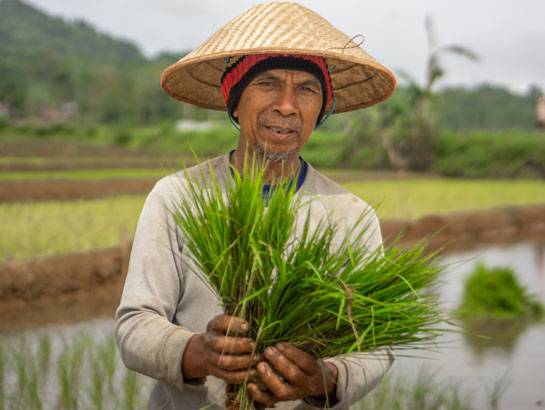Reprinted from The Telegraph, 10/23/23
The underlying reason why the war in Ukraine has had such a significant impact on global food security is because the world is precariously dependent on only a handful of staple food crops.
Just six crops – rice, wheat, maize (or corn), potato, soybeans, and sugarcane – account for more than 75 per cent of total plant-derived energy intake globally.
So, there is no wonder that the conflict between major exporters of wheat and maize has contributed to rising levels of food insecurity. New UN figures indicate that around 735 million people are currently facing hunger, an increase of 122 million from 2019.
More worrisome than the rise in overall hunger, though, is the increase in rates of malnutrition, especially the rising level of micronutrient deficiencies – a more complex challenge that contributes to stunting and wasting in young children, and prevalence of anaemia in women and adolescent girls.
And yet, spikes in global hunger and malnutrition do not need to be the inevitable outcome of shocks like conflict and climate change. A range of alternative solutions exist that can improve the quality of diets and nutrition, while also reducing global dependency on a few staple crops and the countries that dominate their export.
In the first instance, global food supplies would be more resilient and nutritious if they were diversified beyond the “big three” – rice, maize and wheat.
While increases in production and productivity for these crops have played a fundamental role in averting famine and bringing down hunger, they are not suitable in every climate nor the first food of choice for every culture.
Instead, many of the countries left exposed by the grain shortages would have traditionally relied on other, now neglected crops such as millets, teff, manioc, quinoa, cowpea, guar, mustard, and pigeon pea. Millets, celebrated this year by the UN, is a versatile and nutritious group of grains that have long been grown in arid landscapes.
Not only are millets climate-resilient and drought-tolerant, but research has also shown that their nutritional content is key in boosting growth in children and adolescents compared to rice.
In India, where declines in rice production have triggered export bans and sent shockwaves through food markets, millets are enjoying a revival as an affordable, locally adapted and healthy alternative.
Quinoa is another crop worthy of attention and with huge growth potential. It can thrive in extreme soil and climatic conditions, contains all nine essential amino acids, twice as much protein as maize, barley and wheat, and more micronutrients than most staples. Quinoa seed, stems and foliage can be used as livestock and poultry feed and the use of quinoa oil, starch, saponin and colorings are being explored for use in the cosmetic and pharmaceutical industries.
With more investment and support for crop breeding programmes that select the most nutritious and sustainable varieties, crops like millet and quinoa could bolster staple production in other countries, and regions facing food and nutrition security challenges.
From the soil to the sea
Beyond grains, other hardy food crops offer enormous opportunities to diversify and improve diets, particularly through varieties biofortified with micronutrients.
For example, just 125 grams of orange-fleshed sweet potato (OFSP), developed by CGIAR researchers, can meet the daily vitamin A requirement of preschool children. OFSP vines have been disseminated and cultivated in more than 20 countries across Africa and Asia. Aside from directly consuming OFSP, it can also be processed into food products, such as OFSP flour, providing a more nutritious alternative to wheat flour.
Similarly, low-cost, high-yielding and nutritious varieties of beans can contribute to healthier diets. Many iron-biofortified varieties of beans have been disseminated to low-income, rural communities across Africa, where iron deficiency contributes to anaemia in pregnant and lactating women and young children.
Biofortification can also be used to enhance the nutritional quality of diverse, local vegetables and fruit, maximising the health benefits from these foods that are already widely grown and eaten.
Finally, the potential of fish and other aquatic foods has yet to be fully embraced as a key solution to malnutrition challenges worldwide.
While the consumption of aquatic foods in reducing the risk of cardiovascular disease is well recognised, more effort is needed to fully integrate the diversity of aquatic foods into global diets.
Some 3,700 aquatic species are shown to offer a broad range of vitamins, minerals and essential fatty acids, with research indicating that sustainably increasing and diversifying supply could prevent micronutrient deficiencies for a projected 166 million people.
Seaweed is fast gaining recognition as a food with high nutritional value as well as low environmental footprint. However, there needs to be further research and investments to explore opportunities to scale production and consumption of diverse seaweed species, sustainably.
Aquatic food systems are a perfect illustration of how water truly is food and sustains life globally – as the theme for this year’s World Food Day reminds us. With both hunger and malnutrition levels on the rise, food, land and water systems urgently need de-risking and reinforcing. It is imperative for the global community to diversify food production and consumption.
And by embracing diverse, underused, nutritious foods, countries can transform their food systems to become healthy and sustainable.
Shakuntala Haraksingh Thilsted is director of nutrition, health and food security impact area platform for CGIAR – a global research partnership for a food-secure future – and 2021 World Food Prize Laureate; Ismahane Elouafi is chief scientist at the United Nations’ Food and Agriculture Organization.
